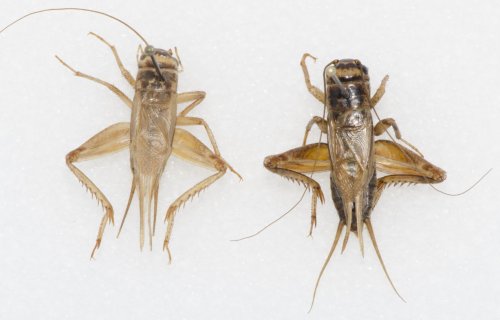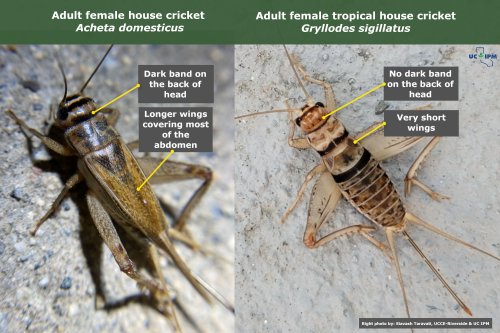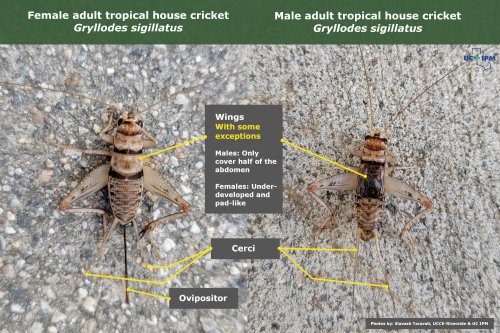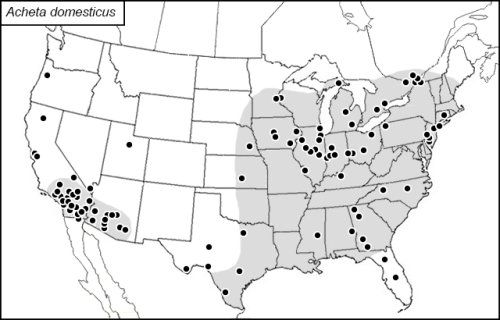House cricket and tropical house cricket differences
Crickets are wonderful creatures that remind us of beautiful meadows at night. Hearing them chirping is a great experience outdoors. However, things become very different when they move inside. Nobody likes to hear crickets chirping nonstop for hours in their kitchen.
There are different types of crickets. Field crickets in the genus Gryllus (Fig. 1) are those that normally live outdoors and rarely get close to buildings. In the U.S., they are usually blackish in color and rarely seen indoors. However, there are other crickets such as the house cricket (Acheta domesticus) and the tropical house cricket (Gryllodes sigillatus)- also known as Indian house cricket, banded cricket, or decorated cricket- which primarily live around human dwellings. These are the ones that become structural pests and can become very annoying. Male crickets of either of these species seek shelters to chirp and find mates. In this process, they may enter homes through various entry points and eventually hide under furniture, kitchen appliances, and other hiding places. Crickets can be surprisingly hard to locate by ear. The reason behind it is probably related to the acoustic nature of their calls, made up of rapid, repetitive sound pulses at high frequencies, which makes it difficult for our brains to detect small timing or loudness differences between the two ears. As a result, the sound seems to come from "everywhere" rather than a specific direction. Even when you accurately locate a cricket inside a home, it can be very difficult to reach them under or behind appliances or cabinets.
Many people, including the pest control industry, may not be aware that there are two common but different species of crickets infesting urban areas in California and Southern states. Here, I will describe each and point out some morphological and behavioral differences.
Differences of the house cricket and tropical house cricket
These two look somewhat similar but can be distinguished by several features mentioned below.
- General Appearance: Both species have an appearance ranging from light tan to dark brown, or even black. An example of such variations in the house cricket can be seen in Fig. 2 (Weissman & Gray, 2019). However, tropical house crickets tend to be lighter in color compared to house crickets (Fig. 3).
- Bands on the head: There are a lot of variations among different populations. However, at least in Southern California, both species have transverse bands on their head. In house crickets, there are usually three (3) dark transverse bands on the head, and the bands seem darker and wider than those in tropical house cricket (Fig. 4). In tropical house crickets, there are usually only two (2) bands on the head since they lack the one on the back of their head (occiput). Instead of a whole dark band on the back of the head, there may be dark veins. Also, transverse dark bands are less pronounced in tropical house crickets (Fig. 4 ).
- Space between antennae: The first segment of the antenna is called the "scape". In house crickets, the space between the scapes of antennae is wider than in tropical house crickets (Fig. 4). In tropical house crickets, the scape is larger, taking more space on the forehead and therefore narrowing the space between the base of antennae (Fig. 4).
- Wings: Both male and female house crickets have longer wings, covering most of their abdomen. In contrast, male tropical house crickets have shorter wings covering only half of their abdomen, and females only have wing pads and are almost wingless (Fig. 5). However, various reports indicate that under certain laboratory and field conditions, wing length may increase or decrease. As a result, wing length alone may not be an accurate feature for identifying these crickets. An example of this can be seen in Fig. 6.
- Behavior: Both species can jump and escape danger. However, tropical house crickets are more agile (Weissman et al., 2012) and harder to catch.
- Chirping or calling songs: House cricket's calling songs have a lower pitch (Dominant frequency 4.8 kHz – Source: www.orthsoc.org) with two pulses per chirp. Tropical house cricket's calls have a higher pitch (Dominant frequency 6.2 kHz) with multiple and more frequent pulses.
- Courtship behavior in tropical house crickets: Males of tropical house crickets are known to provide a nuptial gift to females during courtship. House crickets are not known for such behavior. A nuptial gift is a nutritious material produced by males to encourage courtship in insects, but it may have other roles too. In tropical house crickets, males and females are ready to mate in 3 and 1.5 days after becoming adults, respectively. Male crickets attract females by rubbing their front wings together to produce a chirping sound. Females are attracted to the chirping sound, and when they get close enough, males use their antenna to identify females. Before mating, the male releases a soft, transparent, and gelatinous material called the mating jelly. During mating, the female moves over the male, and the spermatophore and mating jelly are transferred into the female's genitalia. Mating doesn't last long and takes 3-4 minutes on average. Very soon after mating, the female removes the mating jelly and starts feeding on it. The spermatophore, which contains the sperms, stays inside the genitalia for about half an hour, after which it is removed by the female. By that time, the spermatophore is empty. The exact role of mating jelly is not well understood. Although it is not necessary during mating, the mating jelly may increase the chance of successful spermatophore transfer during mating (Subramaniam & Subramoniam, 1990).
- Virus susceptibility: The house cricket is susceptible to a deadly virus (AdDNV) that caused bankruptcy of several large cricket production businesses in 2000s (Weissman et al., 2012). The topical house cricket, however, is not susceptible to this virus.
- Climate: Tropical house crickets are more common in hotter climates (Fig. 6), and house crickets may be found in relatively cooler climates (Fig. 7). They co-exist in many areas of the Southern states (USA) as well as in Mexico.
Management
Crickets can be effectively controlled using granular baits. Sprinkling attractive granular baits outdoors can quickly eliminate or significantly reduce cricket populations. However, not all baits are equally attractive to crickets. I have had great success with Advion Insect Granule (EPA Registration number: 100-1483). These baits are very attractive to tropical house crickets of Southern California. You can see them munching on them right after application. There are several other granular bait products on the market, but I either didn't have good results with them or haven’t tested them yet. While some granular baits can be very effective in controlling tropical house crickets, it is important to know that relying on insecticidal bait alone is not a sustainable way of managing them. Crickets constantly cross property lines and aggregate under stones, debris, and concrete (driveway or sidewalks). As a result, it is important to remove their harborage or hiding places to reduce their reproduction rate.
References
- Subramaniam, M., & Subramoniam, T. (1990). Mating Behaviour and Spermatophore Transfer in Gryllodes sigillatus (Walker) (Orthoptera: Gryllidae). Mitteilungen Aus Dem Museum Für Naturkunde in Berlin. Zoologisches Museum Und Institut Für Spezielle Zoologie (Berlin), 66(1), 65–71. https://doi.org/10.1002/mmnz.19900660108
- Weissman, D. B., & Gray, D. A. (2019). Crickets of the genus Gryllus in the United States (Orthoptera: Gryllidae: Gryllinae). Zootaxa, 4705(1), 1–277. https://doi.org/10.11646/zootaxa.4705.1.1
- Weissman, D. B., Gray, D. A., Pham, H. T., & Tijssen, P. (2012). Billions and billions sold: Pet-feeder crickets (Orthoptera: Gryllidae), commercial cricket farms, an epizootic densovirus, and government regulations make for a potential disaster. Zootaxa, 3504(1), 67–88.








